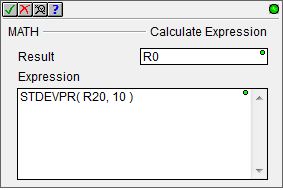Topic: DMD0116
STDEVPR - Population Standard Deviation of a Range
This instruction can only be used in the Expression field of the Calculate Expression (MATH) instruction.
The Population Standard Deviation of a
The expression parameter consists of all the text between the bounding parentheses. Any expression parameter can be a constant value, a bit or numeric memory location, an arithmetic expression, and/or mathematical function or other expressions up to a maximum of 1024 characters. Expressions can be nested, so use of parentheses is recommended to ensure proper evaluation order.
This function has two parameters as follows:

The first parameter designates the first location in the range of
values. This can be any readable bit data-block location or readable numeric
data-block location.
The second
parameter specifies the number of successive locations that are
in the range. Note that this value is a count value, it does NOT specify
the ending location. This can be any constant value from 1 to 65535, or
a bit or numeric memory location, an arithmetic expression, and/or mathematical
function or other expression. Expressions can be nested, so use of parentheses
is recommended to ensure proper evaluation order.
Note: If the second parameter (Range)
is 0 or 1, the result will be set to 0 and ST132 (Argument Out of Range)
will be ON.
Note: If the second parameter (Range) exceeds the size of the data block , the result will be calculated using the values up to the last variable in the block and ST132 (Argument Out of Range) will be ON. For example, assume the block of WX locations has a range of WX0 to WX255. The result of STDEVPR(WX250, 10) would be the Population Standard Deviation of the 6 values in WX250 through WX255, and ST132 (Argument Out of Range) will be ON.
Generally speaking, standard deviation shows how much variation or "dispersion" exists from the average (mean, or expected value). A low standard deviation indicates that the data points tend to be very close to the mean, whereas high standard deviation indicates that the data points are spread out over a large range of values.

This is the mathematical formula used, where N denotes the number of data points, xi denotes each individual data point, and x-bar denotes the average (or mean) of the N data points.
When only a sample of data from a complete population is available, the Population Standard Deviation can be estimated by a modified quantity called the Sample Standard Deviation, which can be calculated using the Sample Standard Deviation of a Range (STDEVR) math function.
See Also:
AVGR - Average of a Range of Values
STDEVPR - Population Standard Deviation of a Range
Related Topics:
Rung Example:
